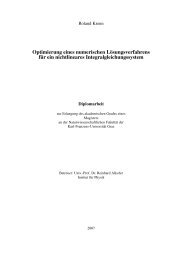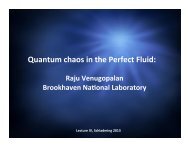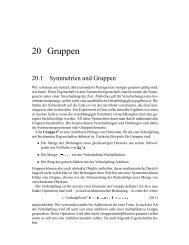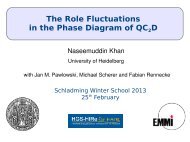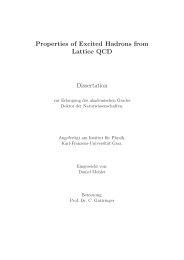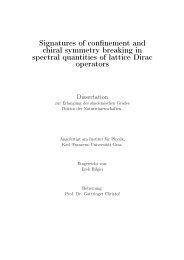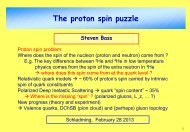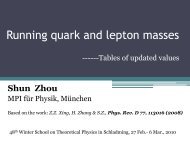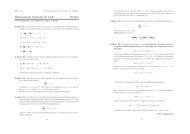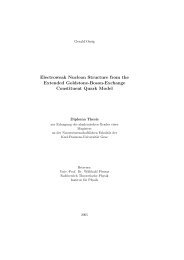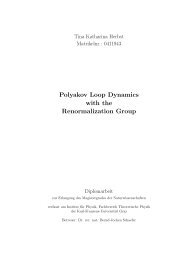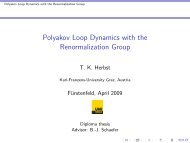The QCD Quark Propagator in Coulomb Gauge and - Institut für Physik
The QCD Quark Propagator in Coulomb Gauge and - Institut für Physik
The QCD Quark Propagator in Coulomb Gauge and - Institut für Physik
Create successful ePaper yourself
Turn your PDF publications into a flip-book with our unique Google optimized e-Paper software.
58 6.2. Two-quark correlations<br />
constant <strong>in</strong> the diquark channel to the coupl<strong>in</strong>g constant <strong>in</strong> the pseudoscalar meson channel.<br />
With scalar <strong>and</strong> axialvector diquarks <strong>in</strong>troduced <strong>in</strong> [HK95] the spectrum of octet <strong>and</strong><br />
decuplet baryons was calculated from the Bethe-Salpeter equation. For the quark exchange<br />
kernel a static approximation was used <strong>and</strong> therefore momentum dependence of<br />
the exchanged quark was not taken <strong>in</strong>to account. This approach violates covariance <strong>and</strong><br />
therefore the rich relativistic structure of models from the type which is used <strong>in</strong> the present<br />
work is approximated by the lead<strong>in</strong>g non-relativistic component, which is the s wave. Calculations<br />
of static nucleon observables with the scalar diquark sector revealed deficiencies<br />
<strong>in</strong> the magnetic moments, which called for an <strong>in</strong>clusion of the axialvector diquark. This<br />
was done <strong>in</strong> [IBY95, MBIY02] with better success, what seems to support the separable<br />
approximation for the two-quark correlation matrix.<br />
If one overcomes the ladder approximation by <strong>in</strong>clud<strong>in</strong>g higher order perturbation<br />
graphs <strong>in</strong> the quark-quark scatter<strong>in</strong>g kernel, the diquark poles disappear both <strong>in</strong> the NJL<br />
model [HAR97] <strong>and</strong> <strong>in</strong> the Munczek-Nemirowsky model [BRVS96]. <strong>The</strong> latter uses a<br />
δ-function for the gluon propagator <strong>in</strong> momentum space <strong>and</strong> can be regarded as complementary<br />
to the former. This suggests that with a more sophisticated gluon propagator<br />
the diquark poles might disappear from the quark-quark scatter<strong>in</strong>g amplitude.<br />
However, the phenomenological quality of us<strong>in</strong>g a diquark correlator to approximate<br />
the two-quark correlation matrix does not rely on the existence of asymptotic diquark<br />
states. <strong>The</strong> diquark correlator is allowed to have no s<strong>in</strong>gularities for timelike momenta,<br />
which is a possible realization of diquark conf<strong>in</strong>ement. One can even employ models with<br />
a general, separable diquark correlator which does not have to possess a simple analytic<br />
structure, imply<strong>in</strong>g that no particle <strong>in</strong>terpretation <strong>in</strong> terms of a diquark is possible. <strong>The</strong><br />
reason for this is that the attractive nature of the <strong>in</strong>teraction mechanism <strong>in</strong> the diquarkquark<br />
picture (the quark exchange) is <strong>in</strong>dependent of the details of the diquark correlations<br />
of the model. This comes from the antisymmetry of the diquark <strong>and</strong> baryon vertices, which<br />
is visible <strong>in</strong> the colour <strong>and</strong> flavour factors of the baryon Bethe-Salpeter equation.<br />
Of course the applicability of the diquark-quark picture <strong>and</strong> the usage of specific diquark<br />
correlations has <strong>in</strong> the end to be judged by comparison to experimental data. This<br />
has to <strong>in</strong>clude more than the octet <strong>and</strong> decuplet spectrum as these masses are not very<br />
sensitive to the level of sophistication <strong>in</strong> the treatment.



